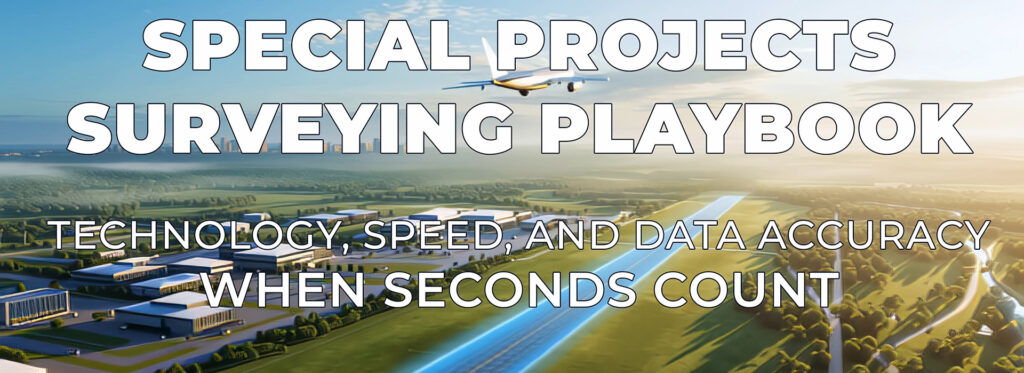Owners, contractors, and agencies thrive on clear facts delivered fast. Special Projects bring together complex sites, moving schedules, and high public visibility, so survey intelligence must arrive quickly and align every stakeholder. ARC Surveying and Mapping focuses on rapid deployment and multi-sensor fusion to provide decision-ready models above and below the waterline.
A rapid-deploy toolkit for complex sites
Special Projects use a modular set of sensors chosen for speed and clarity during urgent or unusual events. The toolkit includes BlueView 3D and side-scan sonar for near-photographic underwater visuals, multibeam and sub-bottom profiling for full bathymetric coverage, static and UAV laser scanning for detailed structures, RTK GNSS and inertial navigation for control, and ADCP for current profiling.
To keep teams aligned, ARC Surveying and Mapping merges these datasets into ArcGeoTwin cloud models that fuse bathymetry, scans, and photos into shareable 3D viewers. The result is a single, field-validated picture of site conditions that supports confident action.
What qualifies as a Special-Project Survey
Special Project Surveys address immediate-need scenarios and out-of-the-ordinary events such as storm impacts, facility incidents, or marine collisions. The goal is rapid response and accurate descriptions of existing conditions that support public-safety decisions and project planning. ARC Surveying and Mapping has delivered these services across North and South America, including the Caribbean.
Four project snapshots that show the range
Panama Canal – Underwater Termite Damage Survey
For the Panama Canal Authority, ARC Surveying and Mapping combined a terrestrial laser scan of the guide wall, a high-resolution multibeam swath survey, and a BlueView sonar scan under the wall. The team generated a 3D computer model using century-old drawings and new survey data, giving engineers the detail required to prepare repair plans for a historic structure.
Mississippi River at Thebes – Illinois Rock Pinnacle Survey
To support safe navigation and efficient excavation, ARC Surveying and Mapping located rock pinnacles with multibeam depth-sounding and tied each survey to St. Louis District contract drawings. A BlueView sonar mounted to the excavator hull guided drill placement, and daily clearance surveys documented progress for the district team.
Raystown Dam, Pennsylvania – Tainter Gate Synchronization Survey
Two position-synchronized terrestrial laser scanners recorded simultaneous XYZ positions on both sides of the moving gate. The continuous, synchronized scan revealed the adjustment needed to achieve smooth, reliable operation and restored safe gate performance.
Golden Ray Salvage – Capsized Demolition Monitoring
During the Golden Ray response near St. Simons Island, ARC Surveying and Mapping provided bi-monthly vessel-mounted laser scans and bathymetric multibeam surveys. The fused 3D model showed demolition progress, debris patterns, and seafloor change influenced by tidal conditions, giving salvors and agencies a measurable view of each stage.
From hours to insight
Special Projects emphasize fast mobilization and parallel data capture. Hydrographic and topographic teams work in concert, and processing starts at the source so that deliverables evolve in near real time. The result is concise drawings, color-graded surfaces, and 3D views that make complex sites easy to interpret for design reviews, safety checks, and construction planning.
How decision makers benefit
The Special Projects approach turns complex field conditions into clear next steps. Owners and agencies gain rapid, reliable descriptions of current conditions. Designers receive engineering-grade context for plans and specifications. Contractors see exactly where to position equipment and how to sequence operations, supported by shared 3D viewers that keep everyone on the same page.
Why technology, speed, and accuracy matter together
Multi-modal sensors minimize access challenges, enhance image quality in turbid water, and capture precise structure geometry at a safe distance. RTK GNSS and inertial navigation provide control in areas with limited benchmarks, and ADCP adds vital current information for planning windows. ArcGeoTwin cloud models integrate every layer into a single frame of reference that teams can explore from any location.
A consistent method across very different sites
From a historic canal guide wall to a riverbed studded with rock pinnacles, from a dam gate mechanism to an ocean salvage corridor, the Special Projects method scales to each environment. The common denominator is disciplined data capture, synchronized scanning, and clear deliverables that support timely, informed decisions when schedules move quickly.

